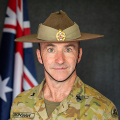This review was originally published in Australian Army Chaplaincy Journal (2020), pp.115-116. Available on the DPN.
...veterans [that] encounter chronic post-traumatic stress disorder (PTSD) is not so much a poor reflection on Army and soldiers, but a result of our broader community’s lack of capacity for cohesion and selflessness, belonging and meaning. It is not veterans that need saving, but their society.
I am a keen observer of the kind of relationships and social capital that makes for healthy people and thriving communities. I love being part of a sports club that cheers each other on, not just for events but for life. The best work groups I have been part of preferred group achievement over individual ambition. Executives in an organisation I worked for quietly took a salary cut, rather than expecting us to. I look back with fondness on streets where neighbours looked beyond their fences to get to know the joys and pains of others. Faith communities I have seen function at their best nurtured the souls of their members and added value to their broader community. A big part of the strength of Army teamwork is the interdependence and loyalty that training and operational service fosters. These observations lead me to ask: what is the making of tribal interdependence and loyalty that fosters wellbeing and flourishing, and what do we do when it is missing? Tribe offers helpful insights particularly for Army and for those who want to support Army members.
Sebastian Junger is the author of books like, The Perfect Storm (made famous by the movie) and War. He wrote War as an immersive journalist about the 15 month tour of a troop in Afghanistan and their almost continuous fighting in difficult terrain. He became curious about why those soldiers were hesitant to return home and why they then felt alienated. It was related to how highly they valued the communal experience of relying on one another. This led Junger to research and write Tribe. He argues, the problems veterans encounter with chronic post-traumatic stress disorder (PTSD) is not so much a poor reflection on Army and soldiers, but a result of our broader community’s lack of capacity for cohesion and selflessness, belonging and meaning. It is not veterans that need saving, but their society.
Junger explains that short-term acute post-traumatic stress is a natural and understandable response to trauma. People have flashbacks to remind them of the danger, hyper-vigilance to avoid situations where they are not in control, anger that helps them be ready to fight and depression that keeps them from actively going back into danger. The bigger mental health problem is when this leads to long-term maladaptive PTSD. They may kill an enemy soldier, or witness such killing, or (even worse for their long-term health) witness a friend die. Most soldiers who experience this, or other terrible experiences, don’t have long-term trauma, but an increasing number of veterans do. Junger reports that about half of Iraq and Afghanistan US veterans have applied for PTSD disability. Some of this may be mis-diagnosis or fraud. But some of it may be because back in society they lack opportunities for collective healing, and lack the interdependence, solidarity, egalitarianism and meaningful contribution that soldiers experienced when in the military.
Tribe underlines the appeal of tribal connection with stories of Sarajevo siege survivors longing for the communal support of the war, statistics of suicide and mental illness declining during conflicts, and nations rallying together during bombing blitzes or natural disasters. History shows that at these times social bonds are reinforced and people commit their energies to the community’s good, rather than just looking out for themselves.
The attraction of tribal living is also shown historically in that many white settlers in North America sought tribal life with the Indians, but very few Indians sought or were content in white society. This raised awkward questions about the 'supposed' superiority of Western society, as Indian society had an appealing tribal egalitarianism, high sense of belonging, and emphasis on sharing rather than private accumulation.
In contrast to the desperate cycles of work, financial obligation and loneliness that are rampant in Western society, Junger argues people are wired to help each other. Risking our lives for others and showing moral courage is what we are born and made for. Like a tribe, this means we need to foster connectedness and places for all people to make a valuable contribution. It means we need to see fraud at any level as a profound betrayal of the group. Bullies need to be faced down by coalitions of senior tribe members. For those who have been exposed to the trauma of war, we need detox ceremonies to confront war’s consequences and prepare for readjustment, such as the American traditions that Junger narrates including the Lakotah Sun Dance and vision quest ceremonies.
Tribe is thought-provoking reading for soldiers and commanders as well as those who seek to understand and support them. It prompted several questions about wellbeing for Army soldiers and veterans that I am looking forward to discussing with colleagues:
- How can we best foster teams with tribal loyalty?
- What are the dangers of tribal thinking e.g. looking down on the weak?
- To foster best practice for promoting soldier and veteran welfare: What can soldiers do? What can their colleagues do? (and) What can the communities that they return to do?
- What else is needed to better prepare soldiers for transition from Army?
- The Apostle Paul expressed his vision for community as an interdependent body, of which he said: ‘If one part suffers, all the parts suffer with it, and if one part is honoured, all the parts are glad’ (1 Corinthians 12:26). What religious resources can inform this kind of belonging and teamwork at its best?
- What locally appropriate processes do we need in Australia for helping soldiers find tribal connections and resilience for the sake of psychological survival?
Note: WO2 Greg Mathers also conducted a review of this book. His video review can be found here.




